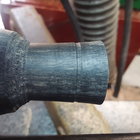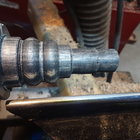john lucas
AAW Forum Expert
I finally had time to do a grit size sharpening test. I picked a piece of wood that easily shows any error in cutting or sanding lines. I used African Ebony. I sharpened my Thompson 1/2" V bowl gouge using the 40/40 method to 40 degree nose angle using mu 350 grit CBN wheel. I made a pass across the ebony. then I ground the same gouge to the same angle using a 36 grit gray wheel. Made a short pass on the end of the ebony. I could not tell the difference. The course grit is the right end and the fine grit is just past the groove. I did it 3 times ( it hurt to grind away that much steel but really it was only probably .010") The test came out the same all 3 times. If I have time tomorrow I might try another wood but I've found the ebony to be a really tell all to how well my tools are cutting. Anyway. I guess the important part of sharpening is to get repeatable angles, make sure you sharpen all the way to the tip ( which can be harder with the finer grits) and sharpen frequently. What grit you use is apparently unimportant. OK now that I said that the finer grits do have some advantages. One is you remove less steel each time you sharpen. An edge ground with a finer grit will last longer. I have seen this in my own experiments but it's well documented in The English magazine Woodturning and there was also an article in American Woodturner the showed this.


